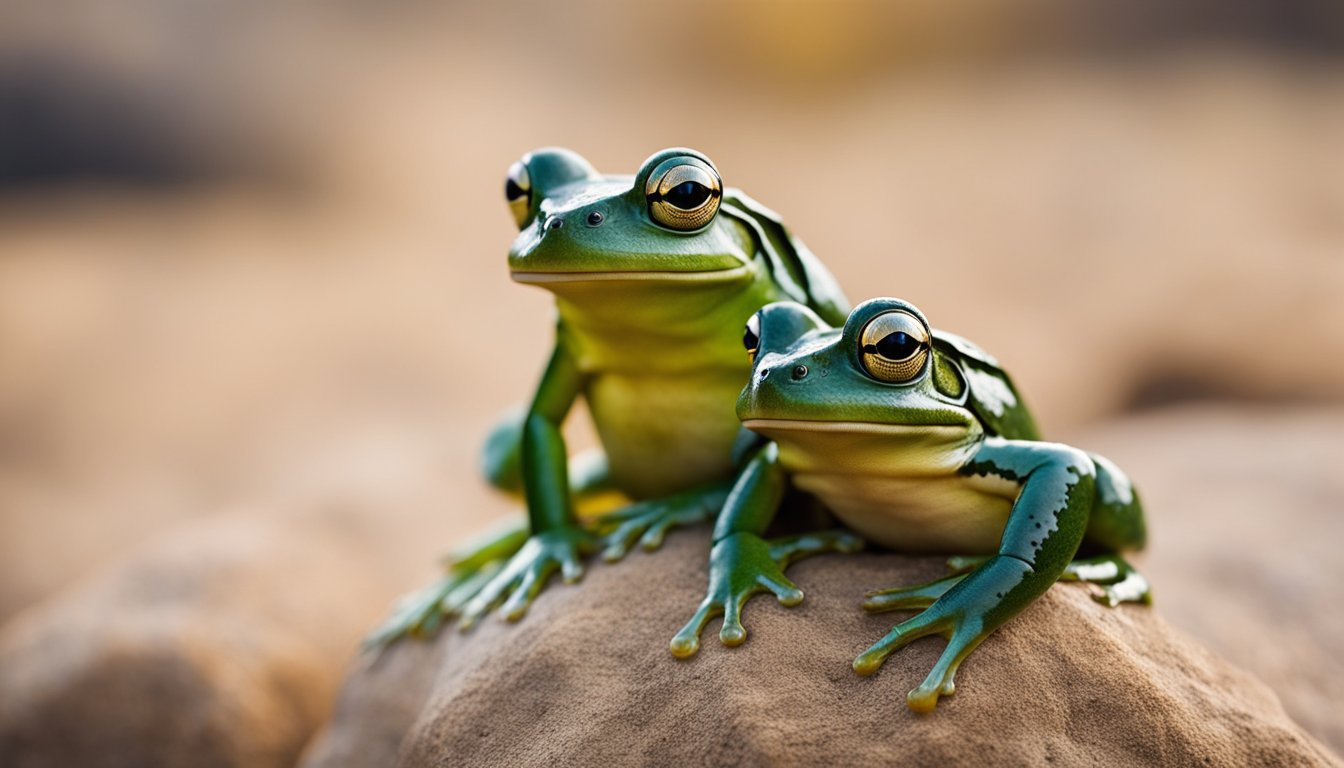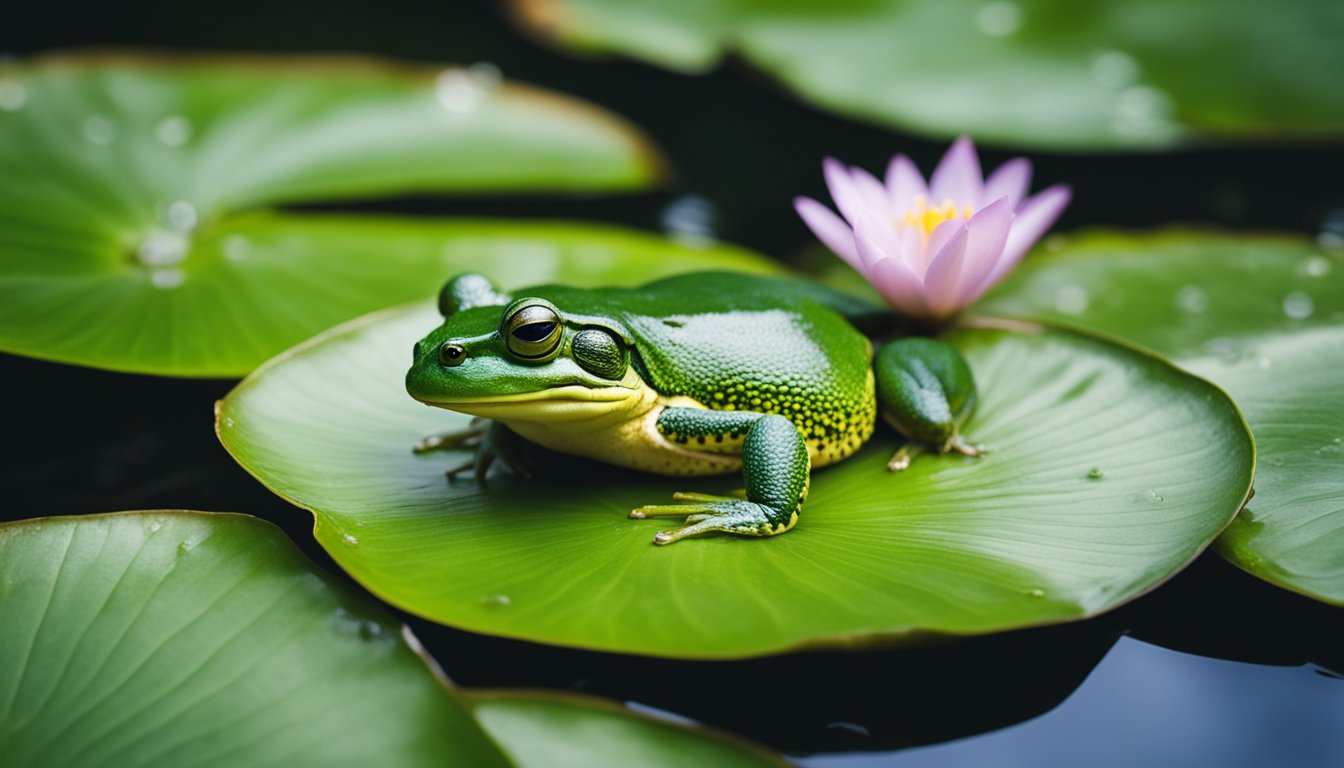Water-Holding Frogs: Australia’s Desert Survivor

Australia is home to some of the world’s most unique and fascinating creatures.
Among them are water-holding frogs, also known as desert frogs, which have developed an extraordinary adaptation to survive in the harsh desert environment.
These remarkable creatures can survive for months without access to water, making them one of the most resilient amphibians in the world.
Water-holding frogs have a unique ability to store water in their bodies, which they can use to survive during periods of drought.
They do this by burrowing underground and absorbing moisture through their skin.
In addition, they have the ability to slow down their metabolism, which helps them conserve energy and water.
This adaptation allows them to survive in the harsh desert environment where temperatures can reach up to 120 degrees Fahrenheit.
Despite their incredible survival skills, water-holding frogs are facing threats from habitat loss and climate change.
As the world’s climate continues to change, it is becoming increasingly important to understand and protect these amazing creatures.
By studying their unique adaptations, scientists can gain insight into how other animals might be able to survive in extreme environments.
The Life of Water-Holding Frogs
Water-Holding Frogs are unique amphibians that have adapted to survive in the harsh, arid deserts of Australia.
These frogs are well-known for their ability to store water in their bodies, which allows them to survive for months without access to water.
Unique Adaptations
Water-Holding Frogs have several unique adaptations that enable them to survive in the desert.
One of the most notable adaptations is their ability to store water in their bodies.
These frogs have a special layer of skin that allows them to absorb water directly through their skin.
They can also store water in their bladder, which swells up to the size of a golf ball when full.
Another adaptation that Water-Holding Frogs have is their ability to slow down their metabolism.
This means that they can survive for long periods of time without food or water.
They also have the ability to bury themselves in the sand to avoid the heat of the day and conserve moisture.
Reproduction and Lifecycle
Water-Holding Frogs have a unique lifecycle that is adapted to the desert environment.
They breed during the wet season, which is usually from December to March.
The males will call out to attract females, and once they have mated, the females will lay their eggs in a shallow depression in the sand.
The eggs will hatch after a few days, and the tadpoles will develop quickly in the warm, shallow pools of water that form after rain.
Once they have metamorphosed into frogs, they will leave the water and begin their life on land.
Water-Holding Frogs have a lifespan of around 5-7 years in the wild.
They are an important part of the desert ecosystem, providing food for predators such as snakes and birds.
They are also an important indicator species, as their presence can indicate the health of the desert environment.
In conclusion, Water-Holding Frogs are fascinating creatures that have adapted to survive in one of the harshest environments on Earth.
Their unique adaptations and lifecycle make them an important part of the desert ecosystem, and their ability to store water in their bodies is nothing short of amazing.
Habitats and Distribution

Water-holding frogs are unique amphibians that have adapted to survive in the harsh conditions of Australia’s desert regions.
These frogs are found in arid and semi-arid areas where water is scarce, and temperatures can reach extreme highs during the day and drop significantly at night.
The water-holding frog’s distribution is limited to the central and western parts of Australia.
They are most commonly found in the states of Western Australia, South Australia, and the Northern Territory.
These frogs inhabit a range of habitats, including sand dunes, rocky outcrops, and floodplains.
Due to their ability to store water, water-holding frogs can survive in areas where other amphibians cannot.
They burrow deep into the sand or soil during the dry season and can remain dormant for months until the rains arrive.
When the rains do come, they emerge from their burrows and absorb water through their skin, which allows them to rehydrate and survive until the next dry season.
Water-holding frogs are a vital part of the desert ecosystem, and their survival is crucial to the survival of other species that rely on them for food.
Despite their unique adaptations, water-holding frogs are still threatened by habitat destruction, climate change, and invasive species.
It is essential to protect their habitats and ensure their survival for future generations to enjoy.
Fun Fact: The water-holding frog is also known as the “fat frog” due to its plump appearance when it is fully hydrated.
Challenges and Conservation

Water-holding frogs face several challenges in their harsh desert environment. One of the most significant challenges is the scarcity of water.
These frogs have adapted to survive in arid regions where water is scarce, but even they struggle during extended periods of drought.
During dry spells, water-holding frogs go into a state of torpor, which is similar to hibernation.
They bury themselves in the ground and reduce their metabolic rate to conserve energy and water.
Another challenge that water-holding frogs face is habitat loss.
As human activity expands into previously untouched areas, the natural habitats of these frogs are being destroyed.
This destruction is leading to a decline in the population of water-holding frogs, which is a cause for concern.
Conservation efforts are underway to protect the water-holding frog and its habitat.
One such effort is the creation of protected areas where these frogs can live undisturbed.
These areas are also being monitored to ensure that the frogs’ habitats are not being destroyed by human activity.
Another conservation effort is the education of the public about the importance of water-holding frogs and their role in the ecosystem.
By raising awareness about these unique creatures, people can be encouraged to take action to protect them and their habitat.
In conclusion, water-holding frogs face several challenges in their harsh desert environment, including water scarcity and habitat loss.
However, conservation efforts are underway to protect these unique creatures and their habitat.
By working together, we can ensure that water-holding frogs continue to thrive in Australia’s deserts for generations to come.
Frequently Asked Questions

How do water-holding frogs manage to thrive in Australia’s arid environments?
Water-holding frogs have adapted to survive in the harsh desert conditions of Australia by developing unique features that allow them to store and conserve water.
They have the ability to absorb water through their skin and store it in their bladder, allowing them to survive for months without access to water.
Additionally, they have the ability to slow down their metabolism and remain dormant during periods of drought, conserving energy and water.
Can you describe the unique diet of the water-holding frog?
Water-holding frogs have a unique diet that consists primarily of termites, ants, and other small insects.
They have a specialized tongue that allows them to capture their prey with ease.
Interestingly, they are also known to eat their shed skin as a source of nutrients.
What are the distinctive physical features of the water-holding frog?
Water-holding frogs have several distinctive physical features that aid in their survival in arid environments.
Their skin is thick and warty, which helps to prevent water loss. They also have a large bladder that can expand to store water, giving them a plump appearance.
Their eyes are positioned on the top of their head, allowing them to see potential predators while remaining hidden in the sand.
What is the lifespan of water-holding frogs in the wild?
The lifespan of water-holding frogs in the wild varies depending on the species.
Some species can live up to 10 years, while others have a shorter lifespan of around 5 years.
Are water-holding frogs considered dangerous or toxic to humans?
Water-holding frogs are not considered dangerous or toxic to humans.
However, it is important to handle them with care and avoid touching their skin, as they may be carrying harmful bacteria.
How have water-holding frogs evolved to cope with the harsh desert conditions of Australia?
Water-holding frogs have evolved over time to cope with the harsh desert conditions of Australia.
They have developed unique physical and behavioral adaptations that allow them to survive in arid environments, such as their ability to store and conserve water, slow down their metabolism, and remain dormant during periods of drought.
These adaptations have allowed them to thrive in a habitat that is inhospitable to many other species.




